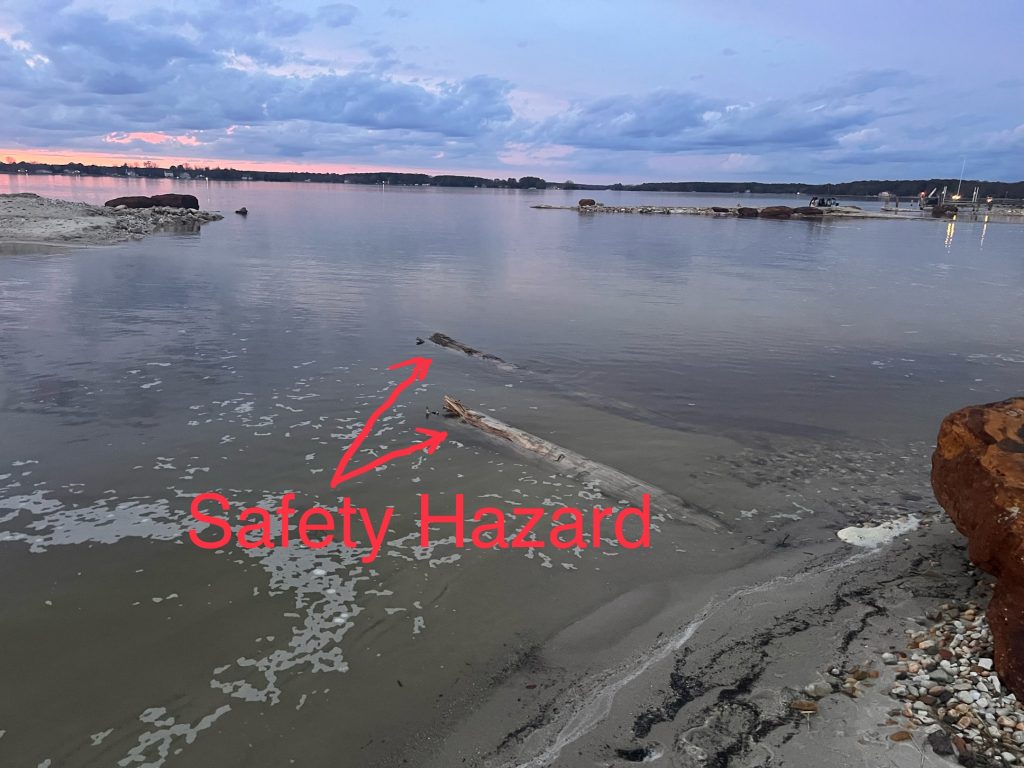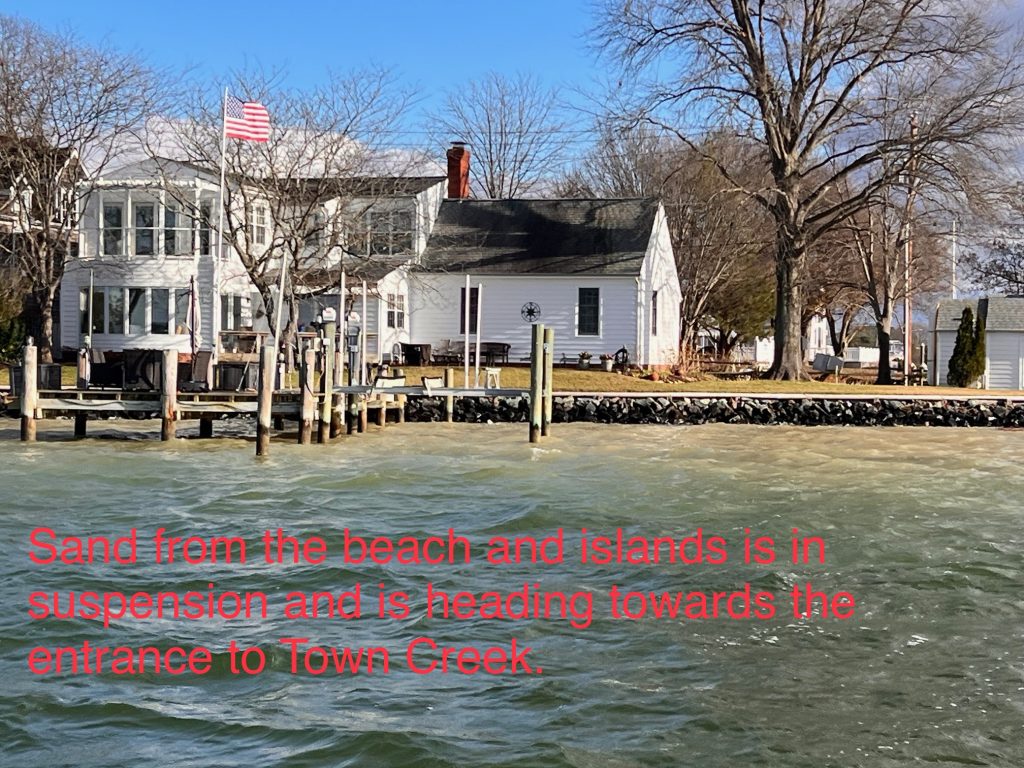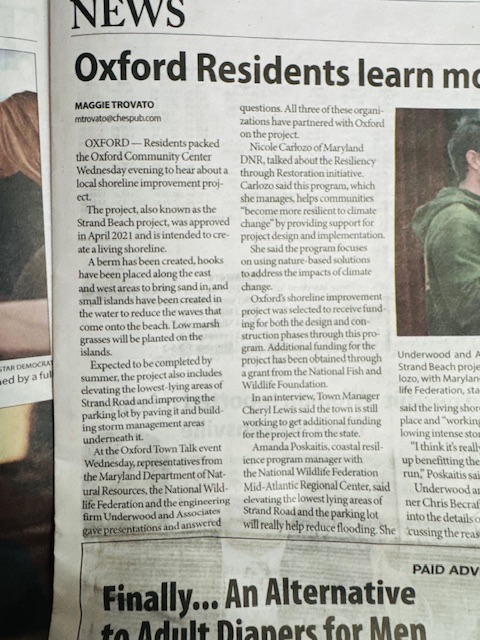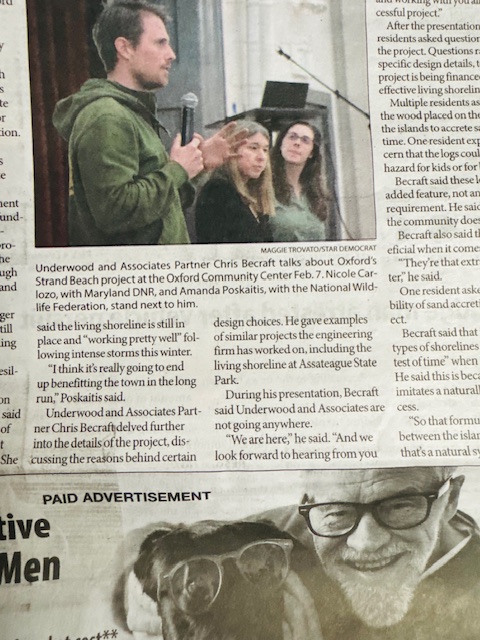
Becraft and Carozza speak at the Oxford Community Center
It was a little less than a year ago that an angry crowd filled the Oxford Community Center to confront the Town Commissioners over the sudden, unexpected retirement of the longtime Police Chief Patrick Maxwell. The Commissioners sat stone faced in front of the room with Town Clerk Cheryl Lewis and Lawyer Lindsay Ryan while citizen after citizen asked questions which they would not answer. Many people walked out as soon as the Commissioners admitted they wouldn't address citizens' questions.
Last night, a similar, less angry crowd attended an "information" session on the Oxford Strand Restoration Project. The project has caused a great deal of frustration and upset in many of those same town residents. This time, the respondents from the Maryland Department of Natural Resource, National Wildlife Federation, and Underwood and Associates, the firm conducting the project, were willing to answer questions.
The problem is that most of their answers did not match up to what residents had been told by town administration about the "restoration," its purpose, origin or approval.
The evening started out with the projection of an old Star Democrat article from 1971 regarding the creation of the iconic stone wall along the Strand, an image that has been the face of Oxford for over fifty years. Town Clerk Lewis read the article with the implication that Oxford has been fighting erosion on the Strand for years and this current solution was just one more in a long line of remedies.

She forgot a couple of facts. That project in 1971 was funded by the Federal Government and did little to change the shape of the Strand. It didn't create static interruptions in the shoreline or "islands" logs and boulders jutting out into the Tred Avon River. And, the seawall seemed to work on most of the Strand except the beach at the very end where erosion did occur during extreme storms and flooding. The retaining wall along the "sweeping shoreline"* remained a beautiful symbol of Oxford.
After introducing the speakers for the evening, Nicole Carlozza (DNR), Chris Becraft (Underwood and Associates) and Amanda Poskaitis (National Wildlife Foundation), Lewis gave the stage over to Carlozza.
In order to understand the comparison between what Carlozza and Becraft ultimately talked about, one has to remember how the project was sold to the town. The town had been told that the restoration was to stop flooding, preserve the beach, and to obtain grant money for both by using the ONLY alternative that the State and or the NWF would accept for grants, living shorelines. Living shorelines are called "green" solutions as opposed to "gray" solutions which are seawalls and bulkheads.
Carlozza explained that the project was part of Maryland's "Resiliency through Restoration" program which was created to provide support for resilience for "climate change" in communities. Living shorelines were described as "using nature to address these impacts."
She also stated that there are many factors that impact towns including rising ground water. Natural solutions are " only one piece of the puzzle" Carlozza said, " and they won't stop flooding."
She said that after Hurricane Sandy, wetlands reduced damages of that storm by about 29%. She didn't say where these wetlands were, whether they were natural or manmade, and exactly HOW they reduced damages. As residents of Oxford who live near some of the manmade "wetlands" and "marshes" in town, will tell you, they do not prevent flooding.
In 2008, Living Shorelines became the "default solution" in the State of Maryland and there are currently thirty projects throughout the State. In an effort to spread this default more, DNR solicits projects from local governments or non-profits through their website.
According to Carlozza, Oxford came in with the project in 2019. (Minutes from town meetings indicate that Oxford began courting this solution on 1/23/ 2018.)
At any rate, DNR accepts bids for these projects based on criteria which include coastal exposure reduction, ecological enhancement, cost efficiency, wildlife benefits, social benefits, equity, local capacity to implement, DEMONSTRATION VALUE, community wide benefits, readiness and ability to proceed, and landowner participation. Carlozza said that the "town" asked DNR to pursue solutions including "living shorelines" to solve erosion and flooding on the Strand.
She never mentioned community or citizen buy in. as well as project monitoring and maintenance from the town.
It's not clear who in the town asked for this option, whether it was elected officials or employees, i.e. the Town Clerk's office, but it is worth mentioning that former Commissioner Pete Dunbar (now deceased) was a big proponent of the "living shorelines" method and that since 2010 a living shoreline had been in place at the Town Park beach and Ferry Dock beach with mixed reviews on the effects, appearance and results.
Carlozza finished by saying that DNR does not design projects but works with partners such as the town and their contractors to complete them therefore absolving them of any responsibility.
Next was Amanda Poskaitis from the National Wildlife Federation who stated in a very brief presentation that the National Fish and Wildlife Federation would fund local projects which were in line with their mission. She noted that Oxford is 4 to 10 feet above sea level. She also stated that they "could have extended the sea wall" on the Strand but as the slide says, "the community collectively decided against" that idea. No one in the crowd remembers a discussion or vote on that idea.

Amanda Poskaitis from the National Wildlife Federation
The final speaker was Chris Becraft who described himself as a "Professional Shoreline Guy" for the firm Underwood and Associates. His firm was "hired by the town" to engineer this solution. Underwood and Associates design projects to withstand "100-year storms." In Oxford's case, they felt this meant providing a 6-foot berm and vegetative islands with terminal hooks on the Strand to grab on to any sand and "accrete" that material at a faster rate. This would occur in Phase One of the project. He then described Phase Two which would elevate the nearby parking lot by 2 feet.
Becraft said they had paused work on the project so they could see what work would be needed as the project is still "laying itself down" which means letting storms come and wash over the islands to see what happens. He also said that the Oxford Strand had a "good seawall "and it was still there but it was "greened over" which is "enivorospeak" for hidden under dirt and sand. (This is the seawall that Poskaitis said was rejected by "the community")
The principles Becraft's firm ascribe to are to do something, "nature based" to fix the problems on any project, including the Strand. For example, the stones in the rip rap currently making up the existing effective sea wall in Oxford were "not found here" so were not acceptable. The boulders placed out on islands were found in our coastal plain therefore they were deemed nature based and acceptable. Obviously, seawalls and bulkheads are not a "nature based" solution.
After showing pictures of other projects of his firm which were in wildlife preserves and rural areas, the session was opened up to questions from residents.
One resident asked about the islands and the fact that the logs placed on them seemed dangerous as children and others would go out to the islands. Becraft claimed that the logs were "an additional feature" that would help accrete sand and support habitat. As for children playing there, he said that was a "perspective" question as to whether or not the town wanted kids to play on them. The logs were as an additional feature were allegedly "community" supported.


Another audience member asked about the "predictability/unpredictability" of the efficiency of this project to accrete sand. Becraft said that the islands are stable and will provide a "natural solution" to erosion. He glibly stated that it is like the old "roach motel" commercial, saying, "sand comes in and never goes out." Some residents have pictures depicting that this may not be entirely accurate as they show sand suspended in the water floating away from the Strand.

Becraft said he would like to see these pictures as that never happens.
A citizen of the town thanked the presenters for being in Oxford to do this presentation which is " four years later than it should have been" alluding to the fact that when the project was designed in the early 2020's citizen input was limited by the fact that meetings were not held in person but virtually. She went on to ask about maintenance of the project. DNR representative Carlozza answered, "Oxford is committed to maintenance." In short, the town will pay. She also stated that this funding for similar projects was under a "pilot" program and that money won't be around forever. **
In a question to Clerk Lewis, a resident asked how much the town gets paid for "finding" these projects. Lewis stated that any work on the grant done by employees of the town gets billed to the grant in an invoice and the grantor reimburses the town.
One resident asked about the fact that the Strand Shoreline was an iconic and beloved landmark of the town for many longtime residents and whether or not the firm had taken this into consideration when they designed the drastic alterations of the shoreline that make it unrecognizable. In his answer, Becraft said they could fix that issue by removing the boulders and the logs and that the islands, which would be planted over in grass, would often be out of sight.
Poskaitis from the National Wildlife Federation dismissively stated to the crowd, "Change is hard."
Other questions were asked about access points to the water and beach across the berms, how high the dunes would be when planted, whether there would be ADA compliance and if the condos across the road would still flood. The dunes will be approximately 2 feet about the roadway and the grasses that will be planted will be 4 feet tall. He clarified that there will not be grasses on the dunes. Becraft maintained that there would be access through pathways across the berms but that some areas would be "unpleasant" to walk through because the grass growing there will be abrasive. If those grasses encroach on other areas, the town will have to manage that. He stated that the condos across from the shoreline would still experience flooding.
The DNR will not be able to pay to provide ADA compliance. That is a problem the town would have to deal with according to Carlozza.
Becraft said he would be happy to welcome the help of residents who wish to plant the sea grasses.
As the evening closed, many residents walked away with the revelation that the project had not been clearly presented nor clearly shared by the town when it was approved. Conflicting statements about what the project could and could not prevent and what its stated purpose was were traced back to town meetings from 2018 to 2023. Many asked "who approved this" and "why did they keep saying that the community asked for this, we never voted on this." Some asked for the names of Commissioners who did approve it. An additional question was why the Tred Avon Yacht Club was the only entity who could change the scope of the project by demanding a planned island by their shoreline be removed from the plan.
It was an evening planned to dispel "rumors" and get community buy in for the Oxford Strand Restoration Project. Based on comments as people left the Community Center, the presentation did not meet that goal.
As it happened over a year ago, the session created more questions than it answered.
*this was how Chris Becraft described the Strand as it was before the project
**In A Star Democrat article dated today,2/9/24, Lewis said," The town is still working to get funding for the project from the State." This brings into question whether the completion of the project will happen.
Oxford Residents learn more, ask questions about Strand Beach project | Local | stardem.com



Link to presentation:
Town Talk-The Strand and more (youtube.com)
ADDITIONAL NOTES; One of the illuminating comments by the DNR during the presentation was that DNR grants projects in order to DEMONSTRATE VALUE. Is Oxford being used as a test case or justification for this type of project?
Previous articles:
What Have They Done To The Oxford Strand? It's Awful! - Easton Gazette
Oxford Floods After December Storm - Easton Gazette
Hundreds Of Years Of Nature's Work Destroyed On Oxford Strand - Easton Gazette
Why Are They Destroying Oxford's Beautiful, Iconic Shoreline? - Easton Gazette